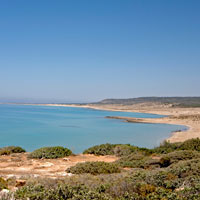It is Ovid’s Metamorphoses that first recount the story of Pygmalion, the legendary Cypriot sculptor who carved a female statue out of pure ivory before falling in love with it, believing it fairer than any woman on the island. He wished that it might live and his prayers were answered by a cupid, who woke her with a kiss; they later married and Paphos is named for it’s founder, their first-born son.
That love story has been influential upon much subsequent literature, and today Paphos is busy reviving itself on the back of that legend and more. The lower city in particular is one of outstanding archaeological sites, gorgeous beaches and pleasant resorts where the only niggle is that its popularity is threatening to degrade it. The upper city is far more earthy, with a great urban scene including some fantastic restaurants populated by real locals far removed from legends of Aphrodite.
Where to stay
Paphos Hotel is fresh, glamorous and clean with a real luxury feel. Asiminia Suits are a great, relaxing place to crash at the end of a long day, with a great range of amenities for both business and leisure needs.
Where to eat
Sienna Restaurant serves some excellent local specialities but also has a wider international menu available. Karlina is another highly-recommended Greek-inspired gem, with an extremely friendly proprietor and serving staff. Sissyfos has a great selection of Mediterranean food and wine and a lovely outdoor seating in which to enjoy your meal.
What to see
The beautifully-preserved mosaics at the Villa of Dionysos are among the finest in the Mediterranean. Kato Paphos Archaeological Park is a World Heritage site and contains many hours worth of fine ruins and archaeological finds. Quiet and peaceful Ayios Neophytos Monastery is another site well worth a visit.





